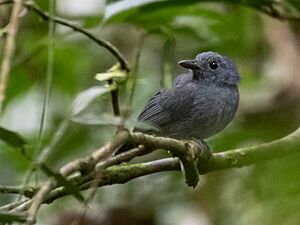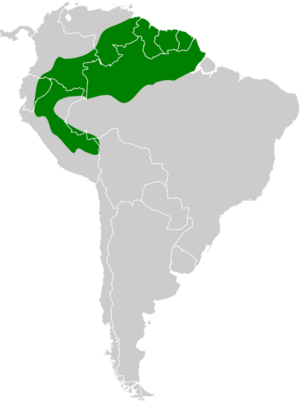Dusky-throated antshrike facts for kids
Quick facts for kids Dusky-throated antshrike |
|
|---|---|
 |
|
| Male at Rio Branco, Acre, Brazil. | |
| Conservation status | |
| Scientific classification | |
| Genus: |
Thamnomanes
|
| Species: |
ardesiacus
|
 |
|
| Synonyms | |
|
Dysithamnus ardesiacus |
|
The dusky-throated antshrike (Thamnomanes ardesiacus) is a type of bird. It belongs to the "typical antbirds" family, called Thamnophilidae. You can find this bird in many South American countries. These include Bolivia, Brazil, Colombia, Ecuador, French Guiana, Guyana, Peru, Suriname, and Venezuela.
Contents
About the Dusky-throated Antshrike
How it Got its Name
Two English bird experts, Philip Sclater and Osbert Salvin, first described this bird in 1868. They gave it the scientific name Dysithamnus ardesiacus. Later, the bird was moved to a different group, or genus, called Thamnomanes. A German bird expert, Jean Cabanis, created this group in 1847.
The name Thamnomanes comes from old Greek words. Thamnos means "bush," and -manēs means "fond of." So, the name suggests a bird that likes bushes!
Different Types of Dusky-throated Antshrikes
There are two slightly different kinds, or subspecies, of the dusky-throated antshrike. They are called T. a. ardesiacus and T. a. obidensis.
What Does it Look Like?
The dusky-throated antshrike is a small bird. It is about 13 to 14 centimeters (5 to 5.5 inches) long. It weighs around 16 to 19 grams (0.56 to 0.67 ounces).
Males and Females
Adult males of the main subspecies are mostly dark gray. Their belly is a bit lighter. Sometimes, they have a small white patch on their back. They might also have some black feathers on their throat. Their wings and tail are dark gray. The tail feathers have tiny white tips.
Adult females look different. Their upper body is dark olive-brown. Their wings and tail have more of a reddish-brown color. Their throat is a creamy white. The rest of their underside is a pale, yellowish-brown.
Subspecies Differences
The T. a. obidensis subspecies has a shorter tail. Its throat is black. Sometimes, it also has some white on its wings.
Where Does it Live?
The main subspecies, T. a. ardesiacus, lives east of the Andes mountains. You can find it from south-central Colombia down through eastern Ecuador. It also lives in eastern Peru, northeastern Bolivia, and western Brazil.
The T. a. obidensis subspecies lives further east. It is found from eastern Colombia across eastern Venezuela and the Guianas. It also lives in northern Brazil, near the Rio Negro river. This subspecies is also found south of the Amazon River.
Its Home in the Forest
These birds mostly live in the lower parts of terra firme evergreen forests. These are forests on higher ground that are always green. They sometimes live in várzea forests too. These are forests that flood seasonally.
They usually live below 500 meters (1,640 feet) in elevation. In some areas, like Colombia, they are found only up to 400 meters (1,312 feet).
How Does it Behave?
Staying in One Place
The dusky-throated antshrike is thought to live in the same area all year round. It does not migrate.
What it Eats and How it Hunts
This bird eats insects and other small creatures like spiders. It usually hunts alone or in pairs. Sometimes, family groups hunt together. They often join "mixed-species feeding flocks." This means they hunt with other types of birds.
They usually look for food from the ground up to about 4 meters (13 feet) high. But they can go as high as 10 meters (33 feet). They often fly from a branch to catch prey from the underside of leaves. They also pick food off the top of leaves, stems, or tree trunks. Sometimes, they drop to the ground to catch prey there. They are known to follow army ant swarms. These ants stir up insects, making them easier to catch.
Making a Home and Raising Chicks
We don't know exactly when their breeding season is. But it includes at least June to October. Their nest is shaped like a cup. It is made from thin, thread-like fungi and other plant bits. Dried leaves are often on the outside. They place the nest in a fork of a branch, usually about 2 meters (6.5 feet) above the ground.
A female usually lays two eggs. The eggs hatch after 11 to 12 days. We don't know how long it takes for the chicks to leave the nest. We also don't know much about how the parents care for their young.
What Does it Sound Like?
The dusky-throated antshrike has a special song. It is a series of notes that start moderately long. Then they get shorter and stronger. The pitch goes up before dropping into a final rough note. People have described its song as "grr, grr, grr-grr-gee-gee-gee-geegeegeegigigi greeeyr."
It also makes different calls. One is a short "chirr." Another is a rough note that goes down in pitch. It also has a clearer, more sudden note. One call sounds like a "sneezing 'tchif!' "
Is it in Danger?
The IUCN (International Union for Conservation of Nature) has looked at the dusky-throated antshrike. They say it is a species of "Least Concern." This means it is not currently in danger of disappearing.
The bird lives across a very large area. We don't know exactly how many there are, but the number is thought to be going down. However, no immediate threats have been found. It is quite common in its habitat. Many large protected areas are part of its home range.


